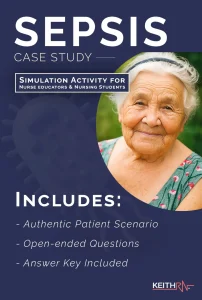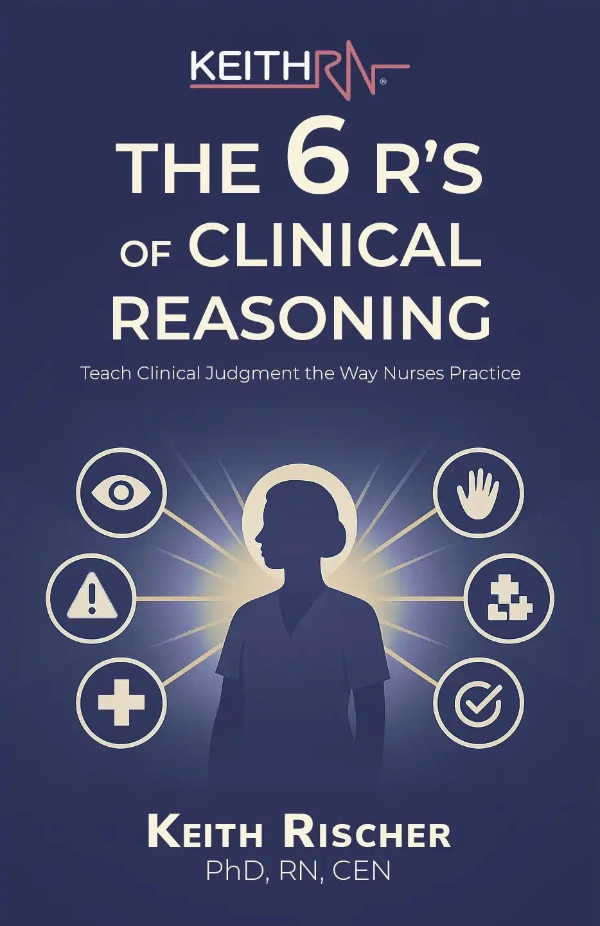
Nursing is a practice-based profession that demands more than memorization. Students must develop clinical judgment, critical thinking, and the ability to apply knowledge in real‑world patient scenarios.
Yet, as we’ve discussed in our recent blog article, “Rethinking ‘Busy Work’ in Nursing Education”, there is a worrisome trend: students are drowning in assignments that feel like time‑fillers rather than meaningful, practice‑oriented learning.
That trend helps explain why many graduates still struggle at the bedside. A 2021 study reported that 91% of new nurses graduate without the essential clinical judgment skills necessary to notice a problem and respond appropriately (Kavanaugh & Sharpnack, 2021), indicating a persistent academic-practice gap.
To effectively prepare students not only to pass the NCLEX but also to think critically, act decisively, and care compassionately as nurses, we need to reconsider our assignments and teaching methods. In our “Busy Work” post, we encouraged educators to eliminate unnecessary tasks, clearly communicate the reasons behind our approaches, and focus on meaningful active learning experiences, such as simulations and case-based teaching strategies.
In contrast to passive lectures or traditional assignments that may be perceived as busywork, case-based learning simulates the critical thinking required in clinical practice. Students must actively engage, analyze, and make decisions, just like nurses do in practice.
Select All That Apply or Simulate Practice?
Multiple-choice questions, commonly used in online case studies from vendors and even in the NCLEX, do not effectively simulate the advanced, open-ended thinking required in nursing practice. When a nurse enters a patient’s room for the first time, there are no options to choose from to determine the next steps to take!
Open-ended clinical reasoning questions, such as “What do you notice that is most important?” with only the data from the medical record to review and choose from, are crucial for better preparing students for real-world practice.
Moving Beyond Passive Learning
Traditional lectures remain common in nursing education, but the evidence suggests they are insufficient for preparing safe and competent nurses. Passive learning may feel easier for students, but it fails to develop higher-level thinking or clinical reasoning.
Research consistently shows that active learning strategies, like case studies, improve student learning outcomes.
- Students in active classrooms are 1.5 times less likely to fail compared to those in lecture-based courses (Freeman et al., 2014).
- Passing grades rise from 67% in traditional classes to 81% with active learning (Aji & Khan, 2019).
- Active learning boosts attentiveness, retention, problem-solving, and teamwork skills—competencies vital for nursing practice.
Strengths of Case-Based Learning
Here’s a few of the strengths that authentic case-based learning offers students.
- Clear purpose and connection to practice. Assignments feel like busy work when their relevance to nursing isn’t made explicit. Case studies should be introduced by explaining how this learning mirrors bedside nursing practice, so students see the activity as more than just another assignment, but as meaningful learning that practices the thinking of practice.
- Active case-based learning is never busywork. By definition, active learning involves meaningful, student-centered, and “higher-level” learning activities (Franco-Tantuico, 2021) that replace rote memorization and the use of games in the classroom. Since games often focus on lower-level learning, prioritizing knowledge over application, they should be used sparingly. Instead, authentic, case-based learning is a more effective, active, student-centered strategy that fosters application-based learning, resulting in deeper understanding and retention.
- Safe place to practice and make mistakes. Students can make errors in a low-stakes classroom environment with a case-based scenario where no patient is harmed by an error in thinking.
Educational Best Practice
McLean (2016), in a systematic review of the nursing and medical literature, identified the following learning benefits of using case studies as a teaching strategy:
- Connects theory to practice
- Facilitates the development of clinical reasoning and decision-making
- Provides repeated experiences to practice clinical judgment in the safety of the classroom
- Immerses students in complex clinical situations they will encounter in practice
- Promotes understanding and deepen knowledge of the most important content
- Improves patient outcomes
Below are additional evidence-based benefits of weaving case-based learning into your nursing curriculum:
- Strengthening Reasoning & Decision-Making. Systematic review notes that case-based learning improves clinical reasoning and decision-making. (Marcomini et al., 2021)
- Improving Clinical Performance & Outcomes. Students exposed to well-constructed cases tend to perform better during clinicals, leading to safer patient care. (McLean, 2016)
- Enhancing Retention & Deep Learning. Cases anchor knowledge in context, making it more memorable than decontextualized lectures. (Kulak et al., 2017; Neilson et al., 2023)
- Increasing Confidence & Engagement. Active, relevant problem-solving enhances students’ confidence in decision-making and their satisfaction with learning. (Marcomini et al., 2021)
- Supporting NCLEX Success. Case-based teaching strategies are correlated with improved NCLEX-RN pass rates. (Young & Willson, 2013; Neilson et al., 2023)
Simulating Clinical Complexity and Ambiguity
Real-world practice is complex and filled with ambiguity. New graduates face multiple patient loads, high acuity, and competing priorities. Authentic case-based scenarios can simulate and practice that ambiguity, requiring students to anticipate risk, respond appropriately to new findings, and re-evaluate interventions in the moment.
In doing so, case-based learning encourages metacognition: students monitor their own thinking and adapt their strategies. This aligns with our call to move beyond superficial tasks toward developing clinical judgment competency.
With case-based learning in the classroom:
- Students can make decisions without jeopardizing patient safety.
- They receive formatively guided feedback.
- They can circle back, reflect, and refine in a way that mirrors continuous learning at the bedside.
Case-based learning is not busywork, it’s an evidence-based, practice-focused strategy that bridges the academic–practice gap by strengthening clinical judgment, improving retention, and preparing nurses to be safe in clinical practice.
 Free KeithRN Case Study
Free KeithRN Case Study
See for yourself the difference that a KeithRN case study makes by practicing clinical thinking using this sepsis unfolding clinical reasoning case study in the classroom, during a clinical post-conference, or as a simulation pre-briefing activity.
Includes student version, answer key, and our white paper titled: The Critical Role of Case-Based Learning in Improving Practice Readiness
How KeithRN Case Studies Develop Clinical Judgment
- Open-ended clinical reasoning questions with no multiple-choice options.
- Clinical reasoning questions that align with Tanner’s Clinical Judgment Model
- Authentic unfolding patient care scenario derived from clinical practice experience, NOT a GPT
- Assessment images and audio links of heart/breath sounds to simulate the sights and sounds of practice
Start laying a foundation of meaningful, higher-level active learning.
- Review every assignment through the lens of “will this be meaningful to improve practice readiness?
- Clearly articulate why the task matters to nursing practice.
- Remove activities that do not provide deep learning of what is most important or practice clinical reasoning skills.
- Replace any “busywork” with practice-informed activities including simulation, case studies, and discussions that provoke reflection and application to nursing practice..
Next Steps
- Start small. Choose one topic or classroom presentation to introduce an authentic patient scenario. Use your lens of practice, or scenarios you have experienced in clinical and HIPAA proof them to use in your teaching.
- Use the four clinical reasoning steps of Tanner’s Clinical Judgment Model as open-ended questions to practice the thinking of practice.
- Use case studies that use open-ended, questions (not multiple-choice) that more closely simulate practice. Remember that multiple-choice questions in a case study prepare students to pass a test. Open-ended clinical reasoning questions prepare them for practice.
- Provide structured feedback and encourage reflection on thinking so students revisit decisions and refine their reasoning.
- Monitor student feedback: if they label it “busy work,” ask why… what’s unclear, what content feels disconnected from nursing practice?
By reimagining your course and content around case-based, practice-rooted learning, you shift from content overload to meaningful learning.
-
Are the assignments I give helping students practice clinical reasoning, or do they risk being perceived as busywork?
-
If I were a nursing student, would I clearly see how this activity connects to bedside practice and prepares me to think like a nurse?
Closing Thoughts
Dr. Patricia Benner’s influential work, Educating Nurses: A Call for Radical Transformation, emphasized the need to contextualize content, integrate classroom and clinical learning, and prioritize clinical reasoning. More than a decade later, this transformation in nursing education remains urgently needed.
Continuing with content-heavy lectures that encourage memorization without application is a form of “educational malpractice”. Nurse educators have both the responsibility and the opportunity to lead change by adopting active, case-based strategies that prepare students for the realities of practice.
The transformation of nursing education occurs one educator at a time, who recognizes that the priority of nursing education is to prepare students for practice. By putting first things first, the NCLEX will take care of itself.
Authentic case studies can bridge the gap between academic knowledge and practical application because they embody the transformational paradigm shifts still needed in nursing education by contextualizing content to practice, integrating class and clinical learning, and emphasizing clinical reasoning.
By consistently using case-based learning, nurse educators can prepare students not only for the NCLEX but, more importantly, improve practice readiness and patient outcomes.
References
Aji, C.A. & Khan, M.J. (2019). The Impact of Active Learning on Students’ Academic Performance. Open Journal of Social Sciences, 7, 204–211. https://doi.org/10.4236/jss.2019.73017
Benner, P., Sutphen, M., Leonard, V., & Day, L. (2010). Educating nurses: A call for radical transformation. Jossey-Bass.
Franco-Tantuico, M. (2021). Active learning: A concept analysis with implications for nursing education. Journal of Nursing Education, 60(10), 573–580. https://doi.org/10.3928/01484834-20210909-05
Freeman, S., Eddy, S. L., McDonough, M., Smith, M. K., Okoroafor, N., Jordt, H., & Wenderoth, M. P. (2014). Active learning increases student performance in science, engineering, and mathematics. Proceedings of the National Academy of Sciences, 111(23), 8410–8415
Kavanagh, J.M., Sharpnack, P.A. (January 31, 2021). “Crisis in Competency: A Defining Moment in Nursing Education” OJIN: The Online Journal of Issues in Nursing Vol. 26, No. 1, Manuscript 2
McLean S. F. (2016). Case-Based Learning and Its Application in Medical and Health-Care Fields: A Review of Worldwide Literature. Journal of medical education and curricular development, 3, JMECD.S20377. https://doi.org/10.4137/JMECD.S2037
Marcomini, I., Terzoni, S., & Destrebecq, A. (2021). Teaching strategies and tools for ensuring safe and quality care: A scoping review. Nursing Education Perspectives, 42(6), 339–343.
Keith Rischer – Ph.D., RN, CCRN, CEN
As a nurse with over 35 years of experience who remained in practice as an educator, I’ve witnessed the gap between how nursing is taught and how it is practiced, and I decided to do something about it! Read more…
The Ultimate Solution to Develop Clinical Judgment Skills
KeithRN’s Think Like a Nurse Membership
Access exclusive active learning resources for faculty and students, including KeithRN Case Studies, making it your go-to resource.







